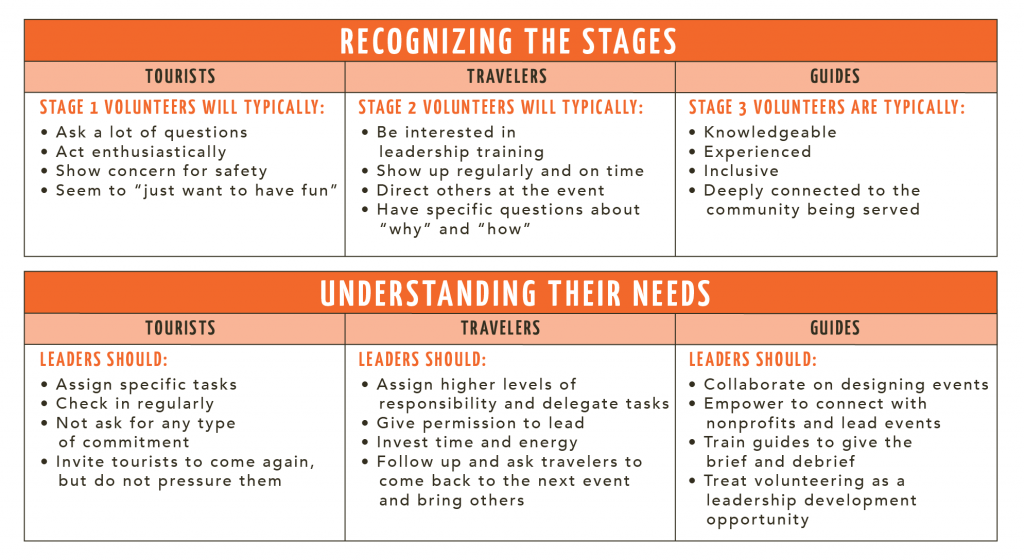Employee volunteers are on a journey. As a tourist, traveler, or guide, your volunteers are each at a different stage of this journey. They need to be supported and treated differently as we meet them at their highest level of contribution. This is one of the greatest feats of CSR practitioners; but with the right tools in place, the path towards transformative volunteering is closer than you think.
By Sabrina Viva
A night at the Oscars!
If you watched the Oscars this year, you may have caught Asghar Farhadi’s acceptance speech highlighting the need for empathy.
“They [the filmmakers] create empathy between us and others. An empathy that we need today more than ever.”
CSR practitioners, like filmmakers, play a unique role in creating the space for empathy to occur.
When we foster the opportunity for employees to act more prosocially through volunteering, it increases their capacity for empathy. Adam Grant found that “when jobs are relationally designed to provide opportunities for contact with beneficiaries, employees may become aware of the significance of their tasks and thereby maintain their motivation in order to have a positive impact on beneficiaries.”
As volunteers connect with beneficiaries who are outside of their typical in-group, and have a chance to critically reflect on their experience, their perceptions are challenged at a psychological, convictional, and behavioral level. This change within the individual volunteer is the foundation of transformative volunteering. This is the change we are after, creating better people, better communities, and a better world!
Why do we need to understand the stages?
Good question!
Your employees might be from all different walks of life and backgrounds. Each one has experienced volunteering differently. For some, like your tourists, it’s probably their first time at bat. Volunteers that are supported and empowered to contribute at their highest level of contribution become strong ambassadors of your program and are central to your program’s success. They also become more confident in their abilities as they develop new skills and connect with the purpose of their work and the impact it has on their community and on themselves.
“Creating a great first experience is key for tourists, who are approximately 70% of your employees.”
If we can get tourists to fall in love with volunteering, they will come back to it. If we can support travelers with their leadership development, they will shine and develop as leaders. And if we can empower guides to forge the way forward, you can build your program on their shoulders and it will flourish with success.
In Empathy in Motion: The Power of Employee Volunteering we will teach you how to enable volunteers to find their place in their journey and discover why they are there and what they need to get out of it.
In case you didn’t get to it yet, Corey outlines the principles that are necessary to have a transformative experience.
Now, let’s build off the brief and debrief and explore the third (and final) keystone behavior: meeting your tourists, travelers, and guides at their highest level of contribution.
Your Tourists
These folks are not hard to spot. Many of them are volunteering for the first time. They are at the stage of casual curiosity. Provide them with clear directions, experiential tasks and don’t expect a long term commitment from them right away. Creating a great first experience is key for tourists, who are approximately 70% of your employees. We need them to fall in love with volunteering so they come back to it again.
Your Travelers
Travelers make up approximately 25% of your volunteers. At this stage of meaningful discovery, travelers are intrinsically motivated to volunteer. Because they feel a sense of belonging, they will continue to come back. Although they may ask a lot of questions and have strong opinions, support them and elevate them by assigning them leadership opportunities. They will shine and be on their way to becoming guides and ambassadors for your program.
Your Guides
You all know who these individuals are. This group of ambassadors makes up 5-10% of your employees. If your program is not yet built on their shoulders, get to it. Your guides are your leaders. They show up early, stay late, pick up all the supplies, invite all of their co-workers to attend, and rave about why volunteering at your company matters. At this stage, guides are intentionally aligned and intrinsically motivated. They get it! And they want everyone else to get it too.
So now that you understand each stage, how do you recognize them and what do they need from you? Here’s a cool reference chart:
Empathy in Motion is open for enrollment now! Starting March 14, 2017, the course offers a new perspective on the power of volunteering that goes beyond the traditional transactional model. Anyone can enroll and can share course details with colleagues, other volunteers, and even family and friends. If you want more details on how to work with your volunteers at each stage, you’ll have to sign up and join us for the free online course.
You can view or download more information at rw.institute including outlines, overviews, and frequently asked questions. You can simply enroll right now by visiting openSAP.
Enroll today!
Realized Worth designs and implements corporate volunteer programs for companies around the world. Want to discuss your program with us? We’ll be happy to hear from you! Find us on Twitter, Facebook, and LinkedIn.

Sabrina Viva
Director of Account Management &
Latin American Initiatives
Follow Sabrina on Twitter
Connect with Sabrina on LinkedIn
